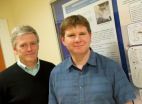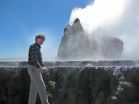(Press-News.org) BOSTON – As any student who's had to study for multiple exams can tell you, trying to learn two different sets of facts one after another is challenging. As you study for the physics exam, almost inevitably some of the information for the history exam is forgotten. It's been widely believed that this interference between memories develops because the brain simply doesn't have the capacity necessary to process both memories in quick succession. But is this truly the case?
A new study by researchers at Beth Israel Deaconess Medical Center (BIDMC) suggests that specific brain areas actively orchestrate competition between memories, and that by disrupting targeted brain areas through transcranial magnetic stimulation (TMS), you can preserve memory -- and prevent forgetting.
The findings are described in the June 26 Advance On-line issue of Nature Neuroscience.
"For the last 100 years, it has been appreciated that trying to learn facts and skills in quick succession can be a frustrating exercise," explains Edwin Robertson, MD, DPhil, an Associate Professor of Neurology at Harvard Medical School and BIDMC. "Because no sooner has a new memory been acquired than its retention is jeopardized by learning another fact or skill."
Robertson, together with BIDMC neurologist and coauthor Daniel Cohen, MD, studied a group of 120 college-age students who performed two concurrent memory tests. The first involved a finger-tapping motor skills task, the second a declarative memory task in which participants memorized a series of words. (Half of the group performed the tasks in this order, while a second group learned these same two tasks in reverse order.)
"The study subjects performed these back-to-back exercises in the morning," he explains. "They then returned 12 hours later and re-performed the tests. As predicted, their recall for either the word list or the motor-skill task had decreased when they were re-tested."
In the second part of the study, Robertson and Cohen administered TMS following the initial testing. TMS is a noninvasive technique that uses a magnetic simulator to generate a magnetic field that can create a flow of current in the brain.
"Because brain cells communicate through a process of chemical and electrical signals, applying a mild electrical current to the brain can influence the signals," Robertson explains. In this case, the researchers targeted two specific brain regions, the dorsolateral prefrontal cortex and the primary motor cortex. They discovered that by applying TMS to specific brain areas, they were able to reduce the interference and competition between the motor skill and word-list tasks and both memories remained intact.
"This elegant study provides fundamental new insights into the way our brain copes with the challenge of learning multiple skills and making multiple memories," says Alvaro Pascual-Leone, MD, PhD, Director of the Berenson-Allen Center for Noninvasive Brain Stimulation at BIDMC. "Specific brain structures seem to carefully balance how much we retain and how much we forget. Learning and remembering is a dynamic process and our brain devotes resources to keep the process flexible. By better understanding this process, we may be able to find novel approaches to help enhance learning and treat patients with memory problems and learning disabilities."
"Our observations suggest that distinct mechanisms support the communication between different types of memory processing," adds Robertson. "This provides a more dynamic and flexible account of memory organization than was previously believed. We've demonstrated that the interference between memories is actively mediated by brain areas and so may serve an important function that has previously been overlooked."
###
This study was supported by grants from the National Institutes of Health (NIH) and the National Science Foundation.
Beth Israel Deaconess Medical Center is a patient care, teaching and research affiliate of Harvard Medical School and ranks third in National Institutes of Health funding among independent hospitals nationwide. BIDMC is a clinical partner of the Joslin Diabetes Center and a research partner of the Dana-Farber/Harvard Cancer Center. BIDMC is the official hospital of the Boston Red Sox. For more information, visit www.bidmc.org.
Study demonstrates how memory can be preserved -- and forgetting prevented
2011-07-10
ELSE PRESS RELEASES FROM THIS DATE:
Study offers new clues about hereditary spastic paraplegia
2011-07-10
HOUSTON -- (July 8, 2011) -- New research from Rice University and Italy's Eugenio Medea Scientific Institute is yielding clues about hereditary spastic paraplegia (HSP), a group of inherited neurological disorders that affect about 20,000 people in the United States. A study in the July 5 issue of the Proceedings of the National Academy of Sciences offers the first detailed account of the biochemical workings of atlastin, a protein produced by one of the genes linked to HSP.
The primary symptoms of HSP are progressive spasticity and weakness of the leg and hip muscles. ...
More Funding, Attention Needed on Elder Abuse in Connecticut
2011-07-10
According to a report by the Government Accountability Office (GAO), Connecticut ranks poorly in the amount of funding and quality of services it provides to victims of elder abuse.
Connecticut ranks 32nd out of 35 states in the amount of money it provides for adult protective services. It also ranks fifth lowest (out of 26) in the number of "substantiated" instances of elder abuse: only 446 of the approximately 3,800 elder abuse reports filed in 2009 were completely resolved or referred for prosecution.
Reaction to the report has been mixed. Some say the ...
Clyde fish stock at 80-year high -- but most are too small to be landed
2011-07-10
Stocks of seabed-living fish in the Firth of Clyde have reached their highest level since 1927 – according to research by academics at the University of Strathclyde.
However, the report, produced by Professor Mike Heath and Dr Douglas Speirs of the University's Marine Population Modelling Group, shows that while fish are actually more abundant than ever, the majority are too small to be landed.
The findings are part of extensive analysis and contradict previous indications from 2010 that the Firth of Clyde had been so heavily fished that it risked being emptied of almost ...
Communication Breakdowns Can Contribute to Medical Malpractice
2011-07-10
A study published in the Archives of Internal Medicine confirms what medical malpractice attorneys and physicians already suspected: There is a breakdown in the lines of communication between primary care physicians, also called PCPs, and medical specialists that could be putting patients at risk.
The study -- which analyzed data compiled by the 2008 Health System Change Health Tracking Physician Survey -- found a marked difference in how PCPs and specialists viewed the quality of information-sharing going on between them. The lack of accurate, timely communication about ...
Behavior-Based Safety Programs Ignore Hazardous Conditions on the Job
2011-07-10
Many employers, including construction companies, have focused on workers' conduct on the job site as the key to ending workplace fatalities and injuries. The AFL-CIO reports that 4,340 workers were killed on the job in 2009, including 184 New York workers. In 2010, OSHA inspectors investigated 40 of the workplace fatalities in New York, but only assessed about $150,000 in penalties to New York employers combined.
Labor advocates argue workers already take on too much responsibility to reduce workplace accidents and improve safety in the workplace. While workers definitely ...
UCSF team describes genetic basis of rare human diseases
2011-07-10
Researchers at the University of California, San Francisco and in Michigan, North Carolina and Spain have discovered how genetic mutations cause a number of rare human diseases, which include Meckel syndrome, Joubert syndrome and several other disorders.
The work gives doctors new possible targets for designing better diagnostics to detect and drugs to treat these diseases, which together affect perhaps one in 200 people in the United States.
On the surface, these diseases look very different. Meckel syndrome causes deadly brain malformations and kidney cysts. Joubert ...
Time Running Out to Participate in 2011 OVDI
2011-07-10
In February 2011, the IRS announced the 2011 Offshore Voluntary Disclosure Initiative. Motivated by the success of previous disclosure programs -- and the federal government's urgent need for more revenue -- the 2011 OVDI is designed to get taxpayers with offshore financial accounts into compliance and to recoup the money in offshore accounts into U.S. tax coffers. It does this by allowing U.S. citizens, green card holders, and U.S. tax residents with previously undeclared offshore accounts to become current with their taxes.
FBAR Reporting Requirement for Offshore Accounts
For ...
Drug designer
2011-07-10
Protease inhibitor drugs are one of the major weapons in the fight against HIV, the virus that causes AIDS, but their effectiveness is limited as the virus mutates and develops resistance to the drugs over time. Now a new tool has been developed to help predict the location of the mutations that lead to drug resistance.
First discovered in 1995, protease inhibitor drugs have dramatically reduced the number of AIDS deaths. Taken in combination with two other anti-HIV drugs, protease inhibitors work by halting the action of the protease enzyme, a protein produced by HIV ...
Agility UK Launches New Website
2011-07-10
Agility UK has launched a new website to promote its health and safety and employment law training and advisory services to businesses across the UK.
Indicating significant progress for the organisation, the launch of the new website better promotes the company's range of cost-effective, flexible and solution-focused health and safety and employment law services.
In a triangulated initiative between a web development team, a leading digital agency, and a design agency, the new website offers refreshed branding, improved usability and more comprehensive information ...
Geothermal industry to get boost from University of Nevada, Reno research
2011-07-10
RENO, Nev. – An ambitious University of Nevada, Reno project to understand and characterize geothermal potential at nearly 500 sites throughout the Great Basin is yielding a bounty of information for the geothermal industry to use in developing resources in Nevada, according to a report to the U.S. Department of Energy.
The project, based in the University's Bureau of Mines and Geology in the College of Science, is funded by a $1 million DOE grant from the American Recovery and Reinvestment Act of 2009. It has reached the one-year mark and is entering phase two, when ...



